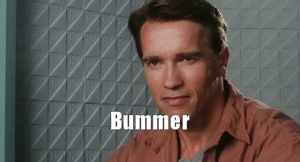My Wikipedia article was nominated for deletion.

This sounds bad. It must be bad. Right? Should I panic? I’m gonna go panic.

Table of Contents
Take a deep breath. You absolutely do not need to panic. Screaming, once, might make you feel better (we know you probably worked long and hard on that article), but panic won’t help. What will help, is finding out exactly what is happening so that you can form the best plan of attack – ahem, we mean, response.
Okay, here we go.
Why do pages get deleted/nominated for deletion?
There are a number of reasons that a page can be nominated for deletion, but the root reason is that the page violates Wikipedia’s page guidelines. Remember that all Wikipedia pages must:
- Cover a topic that is notable enough to merit a page: i.e. one covered extensively by trusted, third-party sources
- Be neutral and objective in tone
- Not violate any copyrights
- Be well-sourced with reliable sources such as academic journals and nation-wide newspapers
- Have sources that are easily verifiable by other editors
Wikipedia provides some specific reasons for deletion here and here. They include:
- Copyright violations
- Advertising without any encyclopedic content
- Articles without any reliable sources
- Articles that fail to meet notability guidelines
- Articles that are simply dictionary definitions or how-to guides
- Routine news coverage
My page was nominated for deletion. Now what?
This depends on the type of deletion. There are three types, and each one comes with a different set of guidelines.
1. Speedy Deletion
We will admit that this situation is more dire than the other two options. If this happens to an article, it is slotted for deletion within the day, and frequently within the hour. Ouch.
However, this isn’t a common occurrence and usually only happens in extreme cases.

This could be because the article was clearly written in bad faith – i.e. it’s extremely critical of its topic, not at all neutral, and focused on promoting a negative opinion. It could also be because an article is a blatant advertisement or absolutely not notable (for example, an article about something that no one has written about except for you on your personal blog). This type of deletion request usually happens shortly after a new page is reviewed by a new page patroller.
If this is your situation, the first thing you need to do is click on the “Contest this speedy deletion” button that appears inside the speedy deletion tag. This will take you to the discussion page where you can explain why you believe the page shouldn’t be deleted. This doesn’t mean writing an incredibly eloquent speech that will move the masses. It means laying out, objectively and factually, the reasons that you believe the page meets Wikipedia’s guidelines.
Depending on how the following discussion proceeds, you might find the page moved to Articles for Deletion (AfD), which means the discussion is going to continue; or you might find that the editor who suggested the Speedy Deletion tag changes their mind. Either way, be patient and don’t panic.
2. Proposed Deletion (PROD)
The PROD process is meant for “uncontroversial deletions.” We can hear you saying, “Is there even such a thing?” Wikipedia editors believe that the answer is, “Yes.”
PROD articles are articles that don’t merit speedy deletion, but that also don’t seem to need much discussion (the AfD process). There a few rules for using this process:
- PROD can never be used simultaneously with a deletion discussion (AfD)
- It can only be used on an article once
- Any editor can object to the tag and remove it
- PROD should only be used if opposition is unexpected
- If after a week, the PROD tag is not removed, the article will be reviewed by an uninvolved administrator. The page will either be deleted, or the tag will be removed.
Before recommending an article for a PROD deletion, editors are encouraged to: consider alternatives, such as improving the page through edits; review the page’s history to ensure it wasn’t recently vandalized; and, check to see if it was previously proposed for deletion.
If this happened to your page, you have two options:
- Remove the template, along with a note that you understand the editor’s concerns and will work to address them. Be very specific in how you will address them and provide a timeline.
- Leave the template in place, and then work to address all the concerns. When you’ve finished, remove the template (remember that you only have 7 days from the time it was placed on the page), and leave a note explaining how you improved the page.

3. Articles for Deletion (AfD)
An article might end up here after going through a proposed deletion, or it might get sent straight to AfD without going through the PROD process. Like the PROD process, saving an article from deletion in this case means addressing the issues that saw it nominated for deletion in the first place. Unlike the PROD process, you can’t just remove the deletion nomination on your own. You have to engage with other editors on the page’s discussion page until a consensus is reached to either save the page or delete it.
You can work on editing the page while discussing its issues. This is better than simply discussing how the page could be fixed, because it shows other editors that it really can be fixed, it isn’t just a hypothetical. Be sure to share on the discussion page any edits that you make.
Sometimes these deletion discussions become very technical, with other editors citing very specific Wikipedia guidelines and policies. For newer editors, this can make it complicated to understand what is being said. Don’t be afraid to ask for clarification and/or for links to articles that define the policies.
As with anything on Wikipedia, you have to exercise patience during this process. There’s no telling how many editors will be involved in the discussion, how many perceived issues will arise, how many differing points of view will be shared, and how long the discussion will last. Be patient, be calm, and don’t panic.
What if my page was already deleted? (Request for Undeletion)

We’re sorry. Here’s what you can do though.
First, check the page’s deletion log to find out why the page was deleted. You can find the log at https://en.wikipedia.org/wiki/Special:Log/delete. Enter the name of your page in the “Target” field, being sure to use exact capitalization, spelling, and spacing. There might also be a link to the deletion log on your article’s talk page.
If your page was deleted via PROD, or after a deletion discussion (AfD) with little to no participation other than the editor who nominated the page for deletion, you can request that the page be undeleted. When you make your request, you can ask that the deleted page be restored as a draft, or that it be emailed to you so that you can work to improve it. Either way, the page is going to need to be significantly improved before you try to publish it again.
If you believe that an editor made a mistake in closing a deletion discussion or in applying a speedy deletion, you can reach out to that editor and discuss the situation with them directly. If you are unable to come to a resolution, you can move the issue to a deletion review. Remember that this is not a chance to express the opinion that you are right and everyone against you is wrong. This is an opportunity to ask for errors in the deletion process to be corrected, or to introduce significant new information that changes the deletion discussion. Treat this as you would any other business process: logically, calmly, and with your position backed up with facts.
This is complicated. How do I get help?

Not surprisingly, this really is complicated, especially when you get into involved discussions with other editors tossing out technical terms seemingly effortlessly (and sometimes, seemingly unnecessarily). If you find yourself in over your head and realize that this is taking up way more time than you have available, don’t be afraid to ask for help.
You can ask other editors to explain the process to you, and they will probably be happy to help. However, they aren’t going to have the time to walk you through every step of the discussion and teach you how to engage properly. For that, you need someone who has Wikipedia expertise, but who stands apart from the specific process. That would be someone like us.
Schedule a time to chat, and we’d love to take a look at your situation, and give our expert advice on the best next steps. Let us untangle the path forward and help you out



